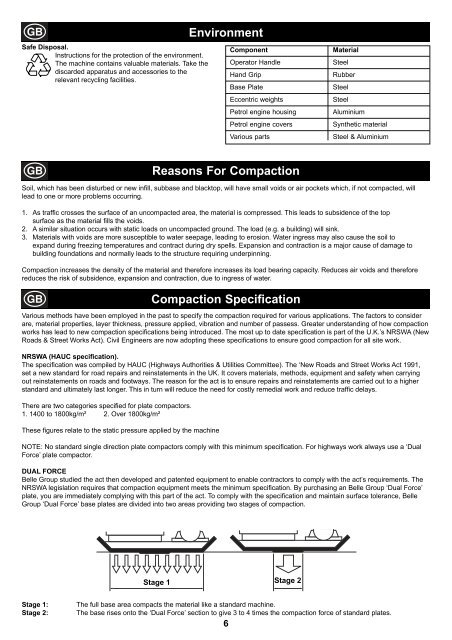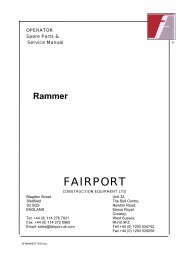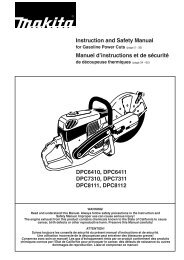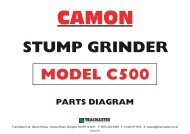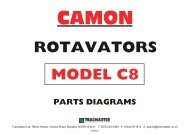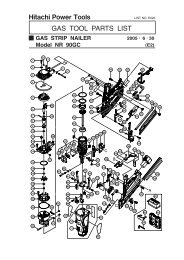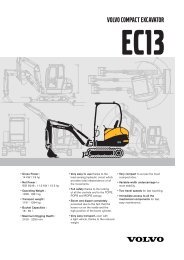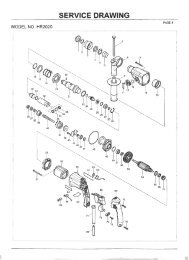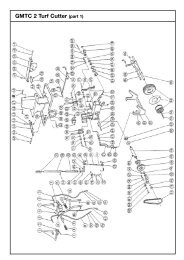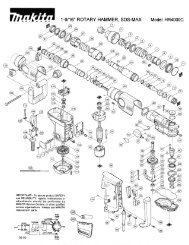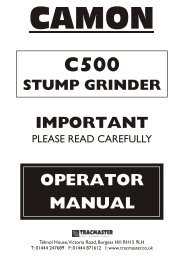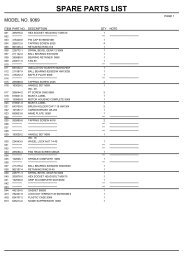Belle - PCLX320 - Light Petrol Compactor Plate - Exsel Plant & Tool ...
Belle - PCLX320 - Light Petrol Compactor Plate - Exsel Plant & Tool ...
Belle - PCLX320 - Light Petrol Compactor Plate - Exsel Plant & Tool ...
You also want an ePaper? Increase the reach of your titles
YUMPU automatically turns print PDFs into web optimized ePapers that Google loves.
GB<br />
Safe Disposal.<br />
Instructions for the protection of the environment.<br />
The machine contains valuable materials. Take the<br />
discarded apparatus and accessories to the<br />
relevant recycling facilities.<br />
Environment<br />
Component<br />
Operator Handle<br />
Hand Grip<br />
Base <strong>Plate</strong><br />
Eccentric weights<br />
<strong>Petrol</strong> engine housing<br />
<strong>Petrol</strong> engine covers<br />
Various parts<br />
Material<br />
Steel<br />
Rubber<br />
Steel<br />
Steel<br />
Aluminium<br />
Synthetic material<br />
Steel & Aluminium<br />
GB<br />
Reasons For Compaction<br />
Soil, which has been disturbed or new infill, subbase and blacktop, will have small voids or air pockets which, if not compacted, will<br />
lead to one or more problems occurring.<br />
1. As traffi c crosses the surface of an uncompacted area, the material is compressed. This leads to subsidence of the top<br />
surface as the material fills the voids.<br />
2. A similar situation occurs with static loads on uncompacted ground. The load (e.g. a building) will sink.<br />
3. Materials with voids are more susceptible to water seepage, leading to erosion. Water ingress may also cause the soil to<br />
expand during freezing temperatures and contract during dry spells. Expansion and contraction is a major cause of damage to<br />
building foundations and normally leads to the structure requiring underpinning.<br />
Compaction increases the density of the material and therefore increases its load bearing capacity. Reduces air voids and therefore<br />
reduces the risk of subsidence, expansion and contraction, due to ingress of water.<br />
GB<br />
Compaction Specification<br />
Various methods have been employed in the past to specify the compaction required for various applications. The factors to consider<br />
are, material properties, layer thickness, pressure applied, vibration and number of passess. Greater understanding of how compaction<br />
works has lead to new compaction specifications being introduced. The most up to date specifi cation is part of the U.K.’s NRSWA (New<br />
Roads & Street Works Act). Civil Engineers are now adopting these specifi cations to ensure good compaction for all site work.<br />
NRSWA (HAUC specification).<br />
The specifi cation was compiled by HAUC (Highways Authorities & Utilities Committee). The ‘New Roads and Street Works Act 1991,<br />
set a new standard for road repairs and reinstatements in the UK. It covers materials, methods, equipment and safety when carrying<br />
out reinstatements on roads and footways. The reason for the act is to ensure repairs and reinstatements are carried out to a higher<br />
standard and ultimately last longer. This in turn will reduce the need for costly remedial work and reduce traffi c delays.<br />
There are two categories specified for plate compactors.<br />
1. 1400 to 1800kg/m² 2. Over 1800kg/m²<br />
These figures relate to the static pressure applied by the machine<br />
NOTE: No standard single direction plate compactors comply with this minimum specifi cation. For highways work always use a ‘Dual<br />
Force’ plate compactor.<br />
DUAL FORCE<br />
<strong>Belle</strong> Group studied the act then developed and patented equipment to enable contractors to comply with the act’s requirements. The<br />
NRSWA legislation requires that compaction equipment meets the minimum specifi cation. By purchasing an <strong>Belle</strong> Group ‘Dual Force’<br />
plate, you are immediately complying with this part of the act. To comply with the specifi cation and maintain surface tolerance, <strong>Belle</strong><br />
Group ‘Dual Force’ base plates are divided into two areas providing two stages of compaction.<br />
Stage 1 Stage 2<br />
Stage 1:<br />
Stage 2:<br />
The full base area compacts the material like a standard machine.<br />
The base rises onto the ‘Dual Force’ section to give 3 to 4 times the compaction force of standard plates.<br />
6


